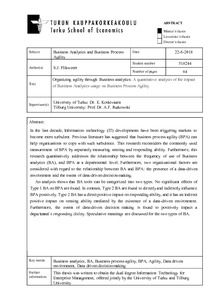Organizing agility through Business analytics : A quantitative analysis of the impact of Business Analytics usage on Business Process Agility
Flikweert, Stan (2018-09-12)
Organizing agility through Business analytics : A quantitative analysis of the impact of Business Analytics usage on Business Process Agility
Flikweert, Stan
(12.09.2018)
Julkaisu on tekijänoikeussäännösten alainen. Teosta voi lukea ja tulostaa henkilökohtaista käyttöä varten. Käyttö kaupallisiin tarkoituksiin on kielletty.
avoin
Julkaisun pysyvä osoite on:
https://urn.fi/URN:NBN:fi-fe2018092736856
https://urn.fi/URN:NBN:fi-fe2018092736856
Tiivistelmä
In the last decade, Information technology (IT) developments have been triggering markets to become more turbulent. Previous literature has suggested that business process agility (BPA) can help organizations to cope with such turbulence. This research reconsiders the commonly used measurement of BPA by separately measuring sensing and responding ability. Furthermore, this research quantitatively addresses the relationship between the frequency of use of Business analytics (BA), and BPA at a departmental level. Furthermore, two organizational factors are considered with regard to the relationship between BA and BPA: the presence of a data-driven environment and the extent of data-driven decision-making.
An analysis shows that BA tools can be categorized into two types. No significant effects of Type 1 BA on BPA are found. In contrast, Type 2 BA are found to directly and indirectly influence BPA positively. Type 2 BA has a direct positive impact on responding ability, and it has an indirect positive impact on sensing ability mediated by the existence of a data-driven environment. Furthermore, the extent of data-driven decision making is found to positively impact a department’s responding ability. Speculative meanings are discussed for the two types of BA.
An analysis shows that BA tools can be categorized into two types. No significant effects of Type 1 BA on BPA are found. In contrast, Type 2 BA are found to directly and indirectly influence BPA positively. Type 2 BA has a direct positive impact on responding ability, and it has an indirect positive impact on sensing ability mediated by the existence of a data-driven environment. Furthermore, the extent of data-driven decision making is found to positively impact a department’s responding ability. Speculative meanings are discussed for the two types of BA.
